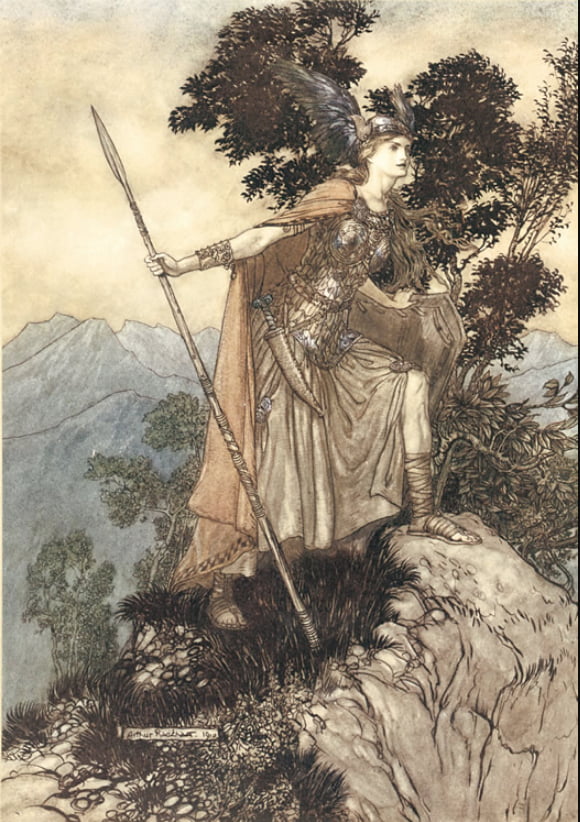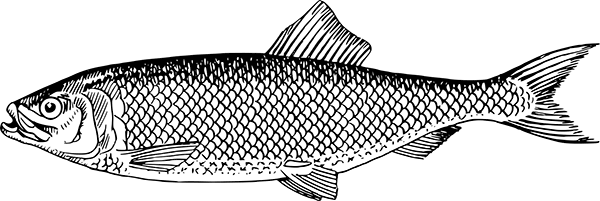The earliest herring poet and the two earliest herring poems, together with the difficulties of dealing with kings
EYVIND SKÁLDASPILLIR
Let then Eyvind ‘Skáldaspillir’ Finnsson (910 – 990 AD) be the first herring poet! At the very least let us credit him with the two oldest herring poems to have survived. Strictly speaking, in Old Norse, it’s Eyvindr and he is regarded as the last major figure in the Norse skaldic tradition. He even gets a mention in Norway’s national anthem.
Dating from the late 960s they come down to us as part of his Lausavísur, a set of 14 occasional single stanza poems. They are recorded individually in Snorri Sturluson’s Heimskringla, the sagas of the Norse kings written around 1230 AD and his earlier Prose Edda. They seem to have been composed in the lean years between Eyvind being skald (court poet) for King Haakon the Good and for the powerful jarl Haakon Sigurdarson – during or just after the uneasy time he spent at the court of Harald Greycoak.
The Poems
As with Anglo-Saxon poetry, the Old Norse tradition works through kennings, figurative word compounds or phrases: ocean-steed or wave- / sea-pig for boat. Sometimes I’ve made these explicit: oar-hooves for sea-feet; both arrow hoard and Egil’s ‘leaping herrings’.
I
South, then! Make our ocean-steed
race on her oar-hooves
toward the promised plenty:
the tail-fin feathered terns of the long nets!
Fortune! See if our sea-pig
can rootle up a silver harvest;
fetch it to a market
that will make our friends fat!
Notes:
1. South – literally from the North. Sturlusun says the expedition took place in the spring, following sightings of herring. Spring spawning herrings generally appear on the south west coast of Norway, from Ålesund to south of Stavanger.
2. The tail-fin feathered terns of the long nets – herrings. I suspect the long nets are a kind of drift net. Both terns and herrings have forked tails. Eyvind is making the connection to bring a third image (arrow fletchings) into play, possibly because ‘leaping herrings’ is an existing kenning for arrows and/or ‘arrows of the sea’ for herrings. It seems likely that he is setting up the second poem. Either way, unlike seine nets, where the herrings are bundled together, hauled out in drift nets the herrings hang singly from their gills. The tension of the hauling will create the image of them momentarily flying like terns – or a hail of arrows – through the air.
II
Icelanders sent me a silver cloak pin.
I spent it on the fjord-herd.
And then on top of that
I had to trade
my arrow hoard
– Egil’s leaping herrings –
for these slender sea-arrows.
Hunger at the heart of each action.
Notes:
1. Icelanders sent me a silver cloak pin – Eyvind wrote a poem for and about the Icelanders, which he performed at their parliament, the Althing. It’s been lost, but they seem to have liked it a lot, clubbing together to make and send him a silver cloak pin, which, when the ornamental clasp work was taken into consideration, Sturluson says was ‘valued at 50 marks’. The gift reached Eyvind when he was back in Norway.
2. Fjord-herd – herring shoal. Sturluson says Eyvind spent all the silver from the cloak pin on cattle, leaving him without the money for the herring expedition, which was why he had to trade his arrows. But Fjord-herd is obviously a herring shoal – and the excellent online Skaldic Project translates it so. In his defence, Sturluson was an Icelander and, mostly, they don’t seem to have been interested in herring fishing until the early 1900s. Salt and wood were both in very short supply in Iceland before, during and long after Sturluson’s time, so they wouldn’t have been able to do much with it. He may have invented the story to explain a mis-kenned kenning.
3. Egil’s leaping herrings – arrows; literally ‘the leaping herrings of Egil’s palm’. Eyvind was known for his use of other skalds’ work (see below). Egil Skallagrímsson, as well as being a fairly brutal Icelandic hero with his own saga, was one of the great skalds. I have decided that Eyvind is referring to a known kenning of Egil’s for arrows (even though he was an Icelander). I think he specifically brings Egil into the frame because of the resonance between the earlier skald’s dealings with Eirik Bloodaxe and Eyvind’s with Harald Greycloak (Eirik’s son); because of what it opens up on the praise poet’s lot, his skill and how he deals with desperate times.
4. Hunger at the heart of each action – grouped around the two costs (the cloak pin and the arrows) I’d suggest Eyvind is expecting his audience to connect the praise poem for the Icelanders, the difficulties of skalding for Harald Greycloak, the consequent loss of patronage and also Egil’s gritted-teeth praise poem skills (see below).
Background to the Poems
Haakon the Good was Eyvind’s great uncle. Possibly with the backing of Athelstan of England, he possibly took the Norwegian throne from his half-brother Eirik Bloodaxe, who possibly then fled to Orkney then York.
Egil Skallagrímsson was a sworn enemy of Bloodaxe, having during Eirik’s Norwegian reign killed a kinsman of Gunnhild (Mrs Bloodaxe / Harald Greycloak’s mother) and then the two of her brothers she sent to kill him in revenge. Declared an outlaw, Egil stuck up a nithing pole (a runic curse pole with a freshly-cut horse’s head on top) targeted at both Mr & Mrs Bloodaxe.
Later, with Eirik now king in York, Egil had the misfortune to get shipwrecked on the Northumbrian coast. Sentenced to death by Eirik, he celebratedly got away with his life by means of the overnight composition of a really good head-ransom poem.
After Eirik’s death at Stainmore on the A66 (954 AD), there were various battles with his sons and Haakon won all of them, but died of an arrow wound from the last one, The Battle of Fitjar (961 AD). After Haakon’s death, Harald Greycloak became king, although he didn’t control all of Norway.

Eyvind remained at court, but the new king didn’t much go for his poems, the loyalty of which was suspect. Eyvind’s Hákonarmál celebrated Haakon’s entry into Valhalla, structurally modelling itself on the Eíriksmál, which Gunnhild (an active force in her son’s reign) had commissioned after her husband’s death.
Eyvind got away with it, but then wrote a poem comparing Haakon’s generosity with gold to the habit Eirik’s sons had of burying it in the ground. He wrote a poem claiming he was getting too old to be praise poet for another king, but only got away with his life this time at the cost of a prized, snake-shaped golden arm band and the writing of another grudging lausavísa to go with it.
He left Harald Greycloak’s court.
The Plagiarist
Those who study the Norse skaldic tradition mostly translate Eyvindr skáldaspillir as Eyvind the Plagiarist. Literally it means skald-(de)spoiler, skald-destroyer.
His incomplete poem Háleygjatal traces the ancestry of his later patron Haakon Sigurdarson back to Odin and is similar to an earlier poem Ynglingatal. His use, however, of Eiríksmal (Eirik Bloodaxe’s entry into Valhalla) to provide the structure for Hákonarmál seems likely to have been a deliberate provocation.
It’s something like the British army’s taking up the French military tune Ça Ira and playing it back to them as The Downfall of Paris. Or maybe closer to playing a tune on a flute made from the bone of your enemy. The original was about Harald’s father and Gunnhild, who had commissioned it, was there. Only the beginning of the former poem survives, but it is a simpler piece. Eyvind, knowing he was writing a better and more complex poem, can be seen as using it to destroy Eirik’s skaldic memory.
The last stanza of Hákonarmál is similar to one from the earlier Hávamál (Sayings of the High One or possibly of the One-Eyed) but that is attributed to Odin and borrowing from the gods doesn’t count.
Plagiarist is pejorative, an accusation of theft without acknowledgment, which doesn’t sit easily either with Eyvind’s poetry or Norse attitudes to plunder. He referenced, used and drew inspiration from the work of others, expecting his listeners to recognise this – but maybe, like many writers in dictatorships, sometimes also wanting it to be deniable.
Thanks and Apologies
I read the Heimskringla when I was 14 – in a phase of post-Tolkien enthusiasm I went through most of the available translated sagas. I missed its significance in herring literature entirely.
I’d like to thank Fiona Cooper for pointing me in the direction of the internationally supported online Skaldic Project (Skaldic Poetry of the Scandinavian Middle Ages – see the link below). At the time, all I had to go on were conflicting versions of the two poems in online texts of the Heimskringla – and neither felt right.
The Skaldic Project is a fantastic resource and this entry draws on it extensively. Its various creators may not agree with all my readings, translations and speculations. This is an online resource too and I’m happy to be corrected on anything!
Meanwhile, what may appear to be a arrow fletching reference to C17th George Herbert’s shaped poem Easter Wings in the second poem was initially unintentional, but then I went with it. It has no relevance to the skaldic tradition, which was essentially oral.
